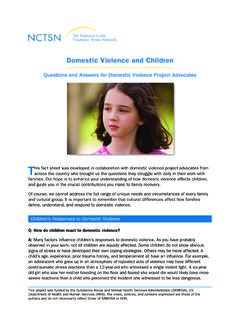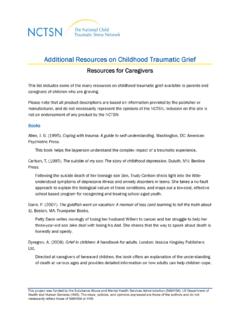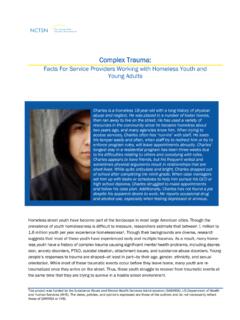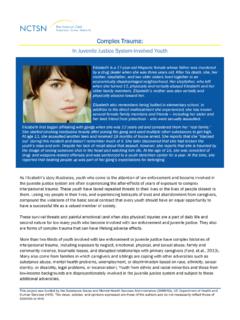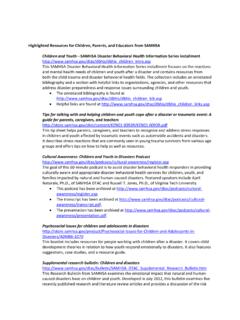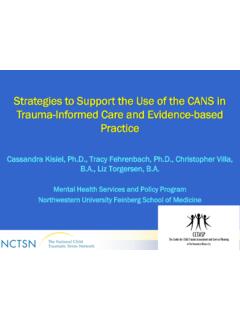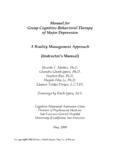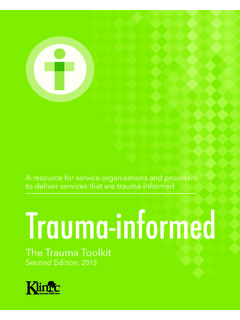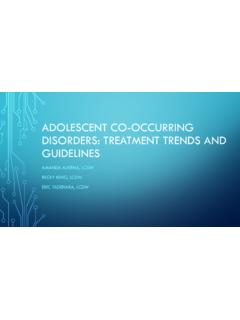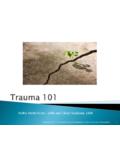Transcription of Domestic Violence and Children - Attorney General
1 This project was funded by the Substance Abuse and Mental Health Services Administration (SAMHSA), US Department of Health and Human Services (HHS). The views, policies, and opinions expressed are those of the authors and do not necessarily reflect those of SAMHSA or Violence and Children Questions and Answers for Domestic Violence Project Advocates This fact sheet was developed in collaboration with Domestic Violence project advocates from across the country who brought us the questions they struggle with daily in their work with families.
2 Our hope is to enhance your understanding of how Domestic Violence affects Children , and guide you in the crucial contributions you make to family recovery. Of course, we cannot address the full range of unique needs and circumstances of every family and cultural group. It is important to remember that cultural differences affect how families define, understand, and respond to Domestic Violence . Children s Responses to Domestic ViolenceQ: How do Children react to Domestic Violence ? A: Many factors influence Children s responses to Domestic Violence .
3 As you have probably observed in your work, not all Children are equally affected. Some Children do not show obvious signs of stress or have developed their own coping strategies. Others may be more affected. A child s age, experience, prior trauma history, and temperament all have an influence. For example, an adolescent who grew up in an atmosphere of repeated acts of Violence may have different posttraumatic stress reactions than a 12-year-old who witnessed a single violent fight. A six-year-old girl who saw her mother bleeding on the floor and feared she would die would likely have more severe reactions than a child who perceived the incident she witnessed to be less dangerous.
4 2 Domestic Violence and Children : Questions and Answers for Domestic Violence Project Advocates November 2010 A child s proximity to the Violence also makes a difference. Consider the very different experiences of a 12-year-old child who was in another room with headphones on while her parents battled; an eight-year-old who had to call 911 despite a raging parent s threats against him; and a teenager who has frequently put himself at risk by getting into the middle of fights to protect his mother from her estranged boyfriend.
5 Here are some of the factors that can influence Children s reactions to Domestic Violence : The severity of the Violence (Was it life-threatening? Did the victim express terror in front of the child ? Was a weapon used or brandished? Was there a serious injury?) The child s perception of the Violence (A child may perceive Violence as life-threatening even if adults do not.)The age of the child (see table, Possible Reactions to Domestic Violence , page 4)The quality of the child s relationships with both parents (or involved parties)The child s trauma history (What other traumatic events has the child experienced?)
6 Was the child also a victim of physical abuse?)Secondary adversities in the child s life, such as moving, changing schools, or leaving behind support systems 1,2Q: What are some typical short-term responses?A: Children commonly respond to Domestic Violence as they do to other traumatic events. Short-term traumatic stress reactions includeHyperarousal. The child may become jumpy, nervous, or easily startled. Reexperiencing. The child may continue to see or relive images, sensations, or memories of the Domestic Violence despite trying to put them out of mind.
7 Avoidance. The child may avoid situations, people, and reminders associated with the Violence , or may try not to think or talk about it. Withdrawal. The child may feel numb, frozen, or shut down, or may feel and act as if cut off from normal life and other people. The national child traumatic stress network 3 Reactions to reminders. The child may react to any reminder of the Domestic Violence . Sights, smells, tastes, sounds, words, things, places, emotions, even other people can become linked in the child s mind with the traumatic events.
8 For example, a school-age child may become upset when watching a football game because the violent contact between players is a reminder of Domestic Violence . Sometimes behavior that seems to come out of nowhere, such as a sudden tantrum, is actually a reaction to a trauma going to sleep or staying asleep, or having nightmares. Repetitive talk or play about the Domestic Violence . For example, a young girl may act out Violence when playing with her dolls. Other short-term symptoms may include anxiety (for example, separation anxiety); depression; aggression (perhaps reenactment of the witnessed aggression); physical complaints (stomachaches, headaches); behavioral problems (fighting, oppositional behavior, tantrums); feelings of guilt or self-blame; and poor academic : What about Children s responses in the long term?
9 A: Research suggests that in the long term, Children who have been exposed to Domestic Violence especially those Children who do not receive therapeutic intervention may be at increased risk ofDepression and anxiety Substance abuse Self-destructive or suicidal behaviors Impulsive acts, including risky sex and unintended pregnancyChronic health problems Low self-esteem Criminal and violent behavior (including perpetration of Domestic Violence ) Victimization by an intimate partner Ariel, an 11-month-old who was present when her mother was attacked by her boyfriend, kept waking up at night screaming.
10 Ten-year-old Paul, who frequently witnessed violent fights between his parents, punched another boy who teased him in line at school. 4 Domestic Violence and Children : Questions and Answers for Domestic Violence Project Advocates November 2010 Q: What are the factors that help Children recover? A: Most Children are resilient if given the proper help following traumatic events. Research has shown that the support of family and community are key to increasing Children s capacity for resilience and in helping them to recover and Crucial to a child s resiliency is the presence of a positive, caring, and protective adult in a child s life.







